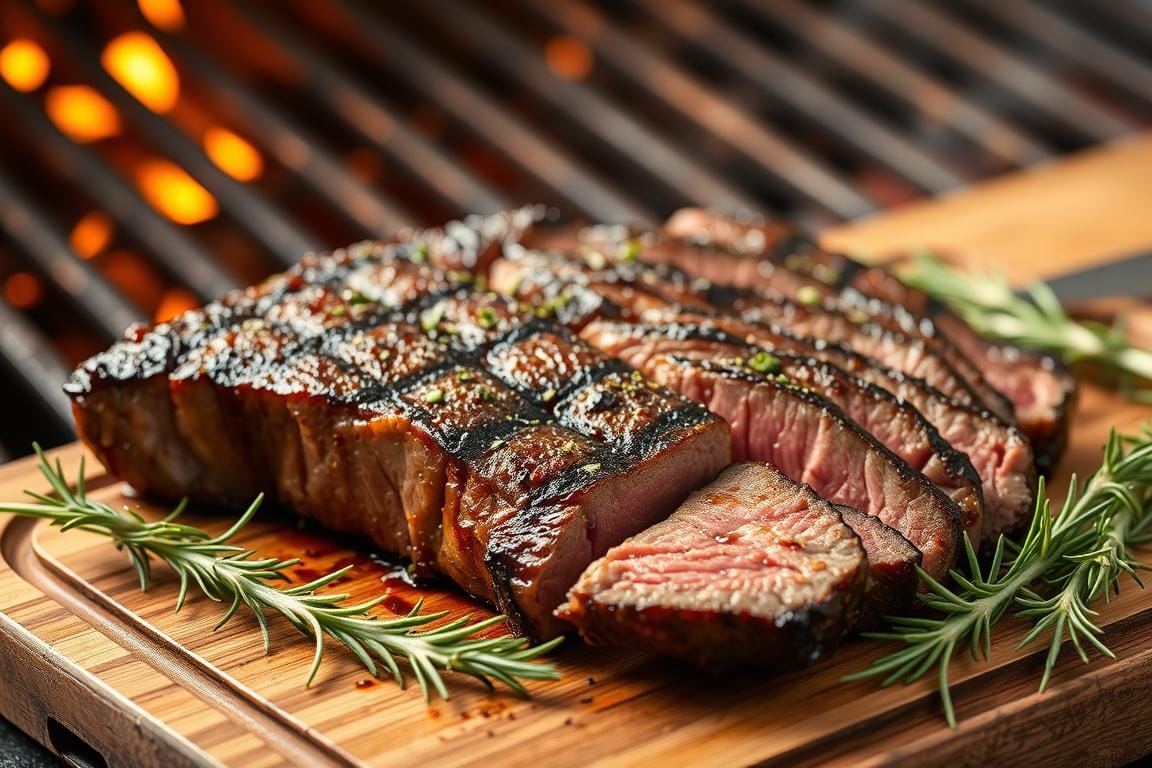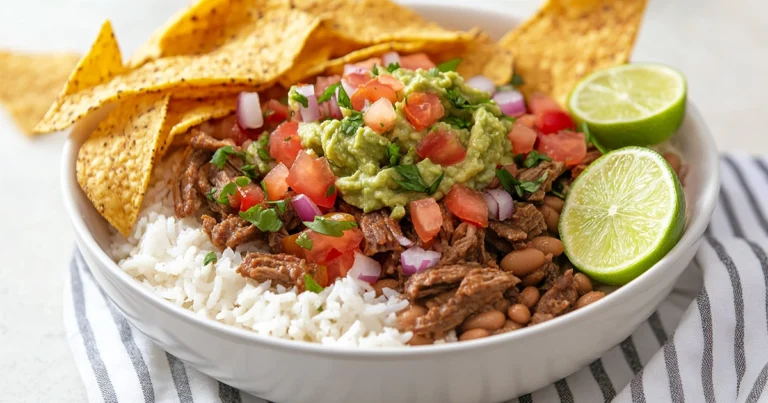Marinated Flank Steak: The Perfect Steak for Any Occasion
Marinated flank steak is the perfect choice when you want a flavorful and affordable cut of beef. This lean steak is budget-friendly, full of flavor, and ideal for weeknight dinners or weekend grilling.
This cut of meat comes from the cow’s lower abdominal muscles, making it a relatively tough cut that’s low in fat. However, with the right preparation, it can become a tender and juicy steak that’s sure to impress.
A good marinade is essential to bringing out the best in this cut, and with the right recipe, you can create a dish that’s both flavorful and memorable.
Table of Contents
What Makes Flank Steak Special
When it comes to steak, few cuts are as versatile and flavorful as the flank steak. This cut of meat has gained popularity for its rich flavor profile and the ease with which it can be prepared. Understanding what makes flank steak special can help you make the most of your culinary endeavors.
Understanding the Cut
Flank steak originates from the lower abdominal area of the cow, distinguishing it from other cuts like the skirt steak, which comes from the diaphragm. This difference in origin contributes to the unique characteristics of flank steak, such as being typically thicker and wider than skirt steak. You’ll find that flank steak is also leaner, with less marbling and fat content compared to skirt steak.
The lean nature of flank steak affects not only its taste but also its cooking requirements. It’s a cut that benefits greatly from marination, which helps to enhance its flavor and tenderness. By understanding the cut, you can better prepare it to suit your taste preferences.
| Characteristics | Flank Steak | Skirt Steak |
|---|---|---|
| Origin | Lower abdominal area | Diaphragm |
| Thickness and Width | Thicker and wider | Thinner and narrower |
| Marbling and Fat Content | Leaner, less marbling | Fattier, more marbling |
Flank Steak vs. Other Cuts
When comparing flank steak to other cuts, several differences become apparent. Unlike premium cuts such as ribeye or filet mignon, flank steak offers excellent value for money while still delivering impressive flavor when cooked correctly. If you’re unable to find flank steak, suitable substitutes include skirt steak, hanger steak, or top round, each with its characteristics.
Understanding these differences is crucial for making informed choices when selecting the right cut for your specific recipe needs and cooking methods. Whether you opt for flank steak or one of its substitutes, being aware of their unique qualities will help you achieve the best results in your cooking.
Why Marinating Flank Steak Is Essential
Marinating the flank steak is a crucial step that elevates the flavor and tenderness of this popular cut. When done correctly, marination can transform a tough piece of meat into a tender and flavorful dish. The key lies in understanding the science behind marination and applying the right techniques.
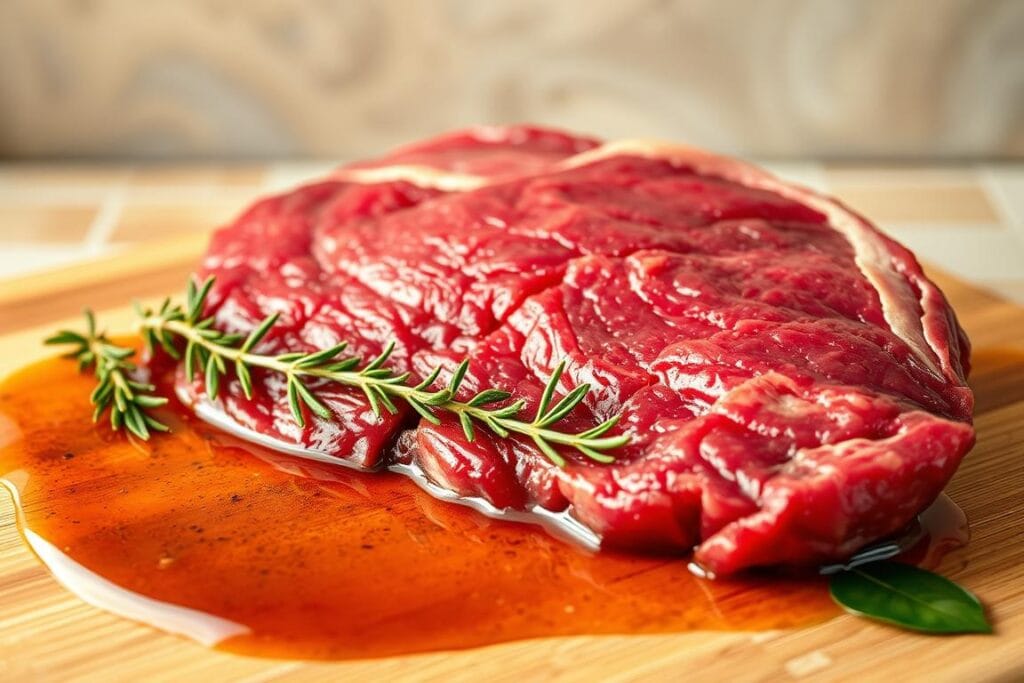
The Science Behind Marination
Marination involves soaking the steak in a mixture of seasonings, acids (like vinegar or citrus), and sometimes oils. The acid in the marinade helps break down the proteins on the surface of the meat, tenderizing it. The seasonings penetrate the meat, enhancing its flavor. Using a food-safe sealable plastic bag, such as freezer Ziploc bags, can be particularly effective as it allows the marinade to envelop the steak completely.
This method ensures that the steak is coated evenly with the marinade, which is crucial for achieving consistent flavor. In contrast, using a shallow dish that doesn’t fully submerge the steak can lead to uneven flavor distribution.
How Long Does It Take to Marinate Flank Steak
The duration of marination can vary depending on the strength of the marinade and personal preference. Generally, marinating flank steak for 2 to 24 hours is recommended. For a stronger flavor, you can marinate it for a longer period, but be cautious not to over-marinate, as this can make the steak mushy. Always keep the steak in the refrigerator during marination to prevent bacterial growth.
Common Marinating Mistakes to Avoid
To get the most out of your marination process, it’s essential to avoid common mistakes. For instance, poking holes in the steak before marinating can cause valuable juices to escape, resulting in drier meat. Similarly, reusing marinade that has come into contact with raw meat without boiling it first can lead to cross-contamination. Using a plastic bag and reserving some marinade before adding the steak can help avoid these issues.
Additionally, failing to turn the steak occasionally during marination can result in uneven flavor absorption. Always ensure that your marinating process is done safely and effectively to achieve the best results.
The Ultimate Marinated Flank Steak Recipe
Now that we’ve explored the benefits of marinating flank steak, it’s time to dive into the ultimate marinated flank steak recipe. This recipe is designed to bring out the best flavor in your steak, making it tender and juicy.
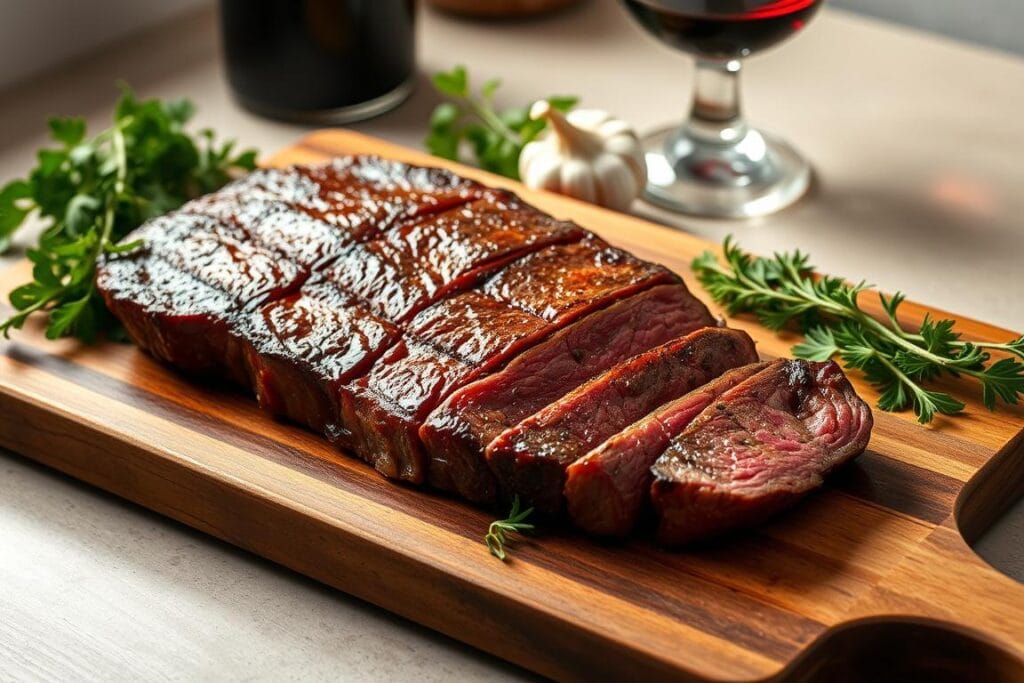
Ingredients You’ll Need
To make this delicious marinated flank steak, you’ll need a few key ingredients. Start with a high-quality flank steak. For the marinade, you’ll need a mix of acidic ingredients like lemon juice and vinegar, along with aromatics such as garlic and spices to add depth to the flavor. Other essential ingredients include olive oil, salt, and pepper.
Here’s a breakdown of the ingredients:
- 1 flank steak (about 1-1.5 pounds)
- 1/2 cup olive oil
- 1/4 cup lemon juice
- 2 cloves garlic, minced
- 1 tablespoon balsamic vinegar
- 1 teaspoon dried oregano
- Salt and pepper to taste
- Optional: red pepper flakes for some heat
Step-by-Step Preparation
Preparing your marinated flank steak is straightforward. First, combine the marinade ingredients in a bowl. Place the flank steak in a large zip-top plastic bag or a shallow dish. Pour the marinade over the steak, turning to coat it evenly. Seal the bag or cover the dish, then refrigerate for at least 2 hours or overnight.
When you’re ready to cook, preheat your grill or broiler. Remove the steak from the marinade, letting any excess liquid drip off. Cook the steak to your desired level of doneness. After cooking, let the steak rest before slicing it thinly against the grain.
Marinade Variations to Try
One of the best things about this recipe is its versatility. You can easily customize the marinade to suit your taste preferences. For example, you can swap citrus by using lime or orange juice instead of lemon. You can also experiment with different types of vinegar, such as red wine vinegar, or add various seasonings to change up the flavor profile.
Some ideas for variations include:
- Add a spicy kick with red pepper flakes or chipotle powder
- Creating an Asian-inspired flavor with ginger, soy sauce, and sesame oil
- Incorporating fresh herbs like parsley, oregano, or thyme into the marinade
- Serving the steak with a complementary sauce, such as chimichurri
By experimenting with different ingredients and flavors, you can create a unique marinated flank steak recipe that’s all your own.
Perfect Cooking Methods for Marinated Flank Steak
To achieve a mouth-watering flank steak, it’s essential to choose the right cooking method after marination. The cooking technique you select can significantly impact the final texture and flavor of your steak. In this section, we’ll explore various cooking methods and provide tips to help you cook your marinated flank steak to perfection.
Grilling Flank Steak to Perfection
Grilling is a popular method for cooking flank steak as it adds a smoky flavor and a nice char on the outside. To grill your flank steak, preheat your grill to medium-high heat. Remove the steak from the marinade, letting any excess liquid drip off. Grill the steak for 5-7 minutes per side or until it reaches your desired level of doneness. After grilling, let the steak rest for a few minutes before slicing it thinly against the grain.
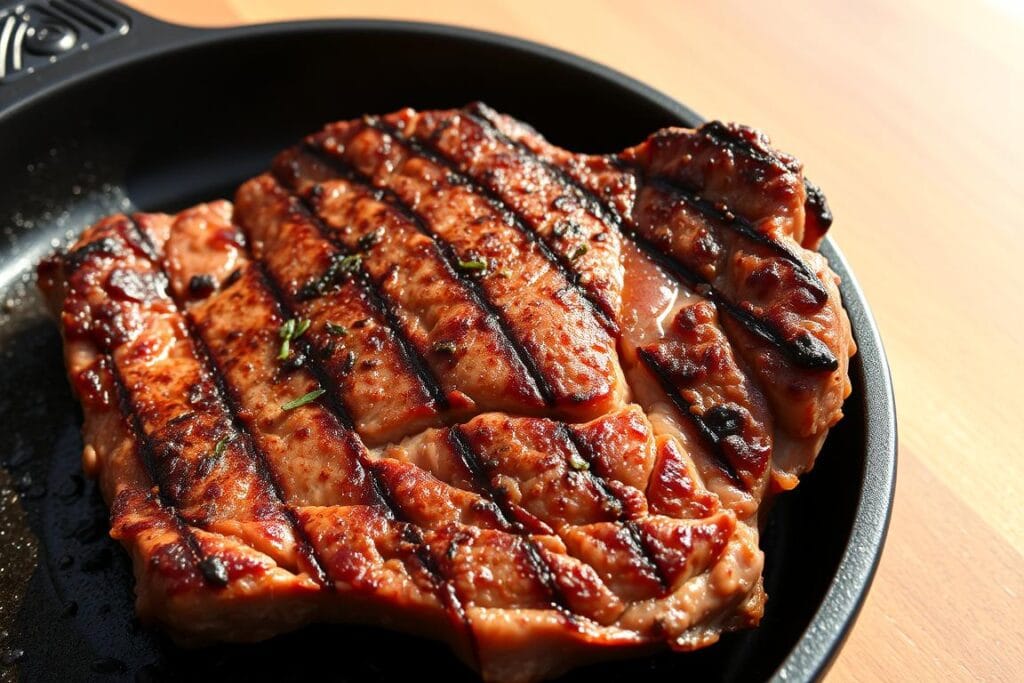
Oven-Broiled Flank Steak
Oven broiling is another excellent way to cook flank steak, especially when grilling isn’t an option. To oven-broil, preheat your broiler and position the oven rack about 4-6 inches from the heat source. Place the marinated flank steak on a broiler pan and broil for 5-7 minutes per side or until it reaches your desired level of doneness. Keep an eye on the steak to prevent overcooking.
Stovetop Cooking Method
Cooking flank steak on the stovetop is a quick and easy method that yields great results. Heat a skillet or cast-iron pan over medium-high heat. Remove the steak from the marinade and add it to the hot pan. Cook for 4-6 minutes per side or until the steak reaches your desired level of doneness. Use a thermometer to check the internal temperature for accuracy.
Determining Doneness
Determining the doneness of your flank steak is crucial to achieving the perfect cook. The most accurate way to check doneness is by using an instant-read thermometer. Insert the thermometer into the thickest part of the steak. For medium rare, the internal temperature should be around 135°F. Here’s a general guide for internal temperatures:
| Doneness Level | Internal Temperature (°F) |
|---|---|
| Rare | 125 |
| Medium Rare | 135 |
| Medium | 145 |
| Medium Well | 155 |
| Well Done | 165 |
Remember, the steak will continue to cook a bit during the resting period, so it’s best to remove it from heat when it’s about 5°F below your target temperature. This ensures that your steak is cooked just right.
The Critical Resting Period
The resting period is a critical phase in cooking marinated flank steak that should not be overlooked. After you’ve grilled your steak to perfection, it’s time to let it rest. Transfer the grilled flank steak to a plate and let it rest for 10 minutes before slicing.
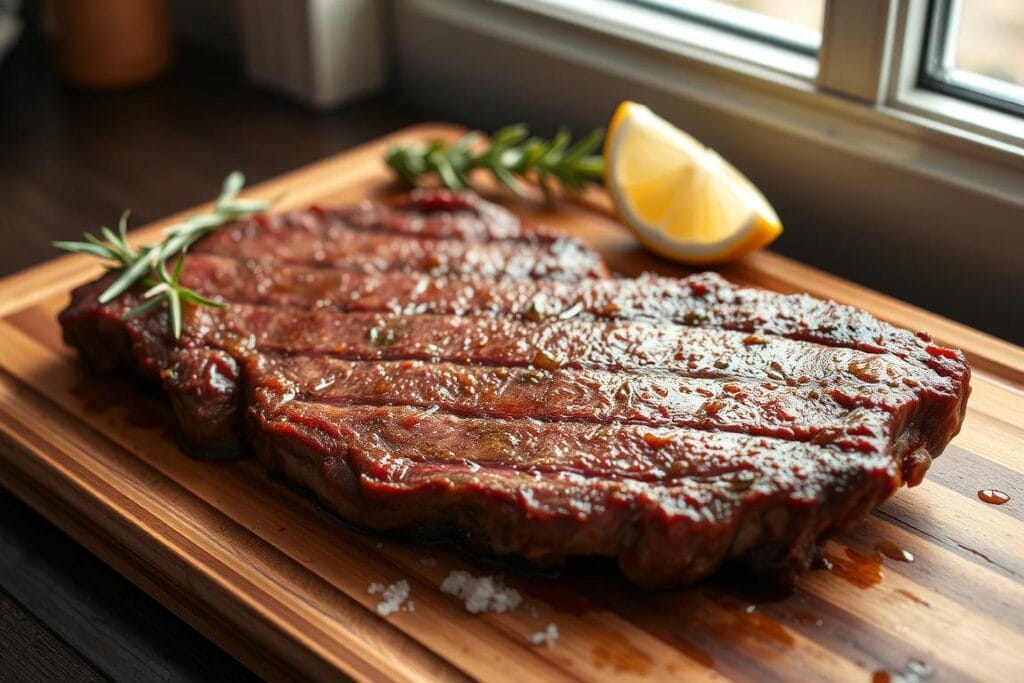
Why Resting Matters
Resting your steak allows the juices to redistribute, making the steak more tender and flavorful. When you cook a steak, the heat causes the juices to move toward the surface. By letting it rest, you’re giving the juices time to redistribute throughout the meat, resulting in a more enjoyable dining experience.
How Long to Rest Your Steak
For flank steak, the optimal resting time is 8-10 minutes, providing sufficient time for juice redistribution without allowing the meat to cool too much. You can loosely tent your steak with aluminum foil during this period to retain some heat while allowing excess steam to escape. Use this time to prepare your serving platter or finish any accompanying dishes.
- The ideal resting time may vary depending on the thickness of your steak.
- Larger cuts may require slightly longer resting periods, while thinner portions might need only 5-7 minutes.
Resist the temptation to cut into the steak early, as this defeats the purpose of resting and results in juice loss.
Slicing Techniques for Tender Results
Achieving tender and flavorful slices of flank steak requires the right slicing technique. The way you slice your steak can significantly impact its tenderness and overall dining experience.
Understanding “Against the Grain”
Slicing your flank steak “against the grain” is crucial for tenderness. This means cutting the meat in a direction perpendicular to the lines of muscle fibers visible on the surface. By doing so, you shorten the fibers, making the steak easier to chew.
To identify the grain, look for the parallel lines or fibers on the surface of the steak. Once you’ve identified the grain, position your knife accordingly to slice against it. For a more appealing presentation, consider slicing at a slight angle, about 45 degrees, against the grain.
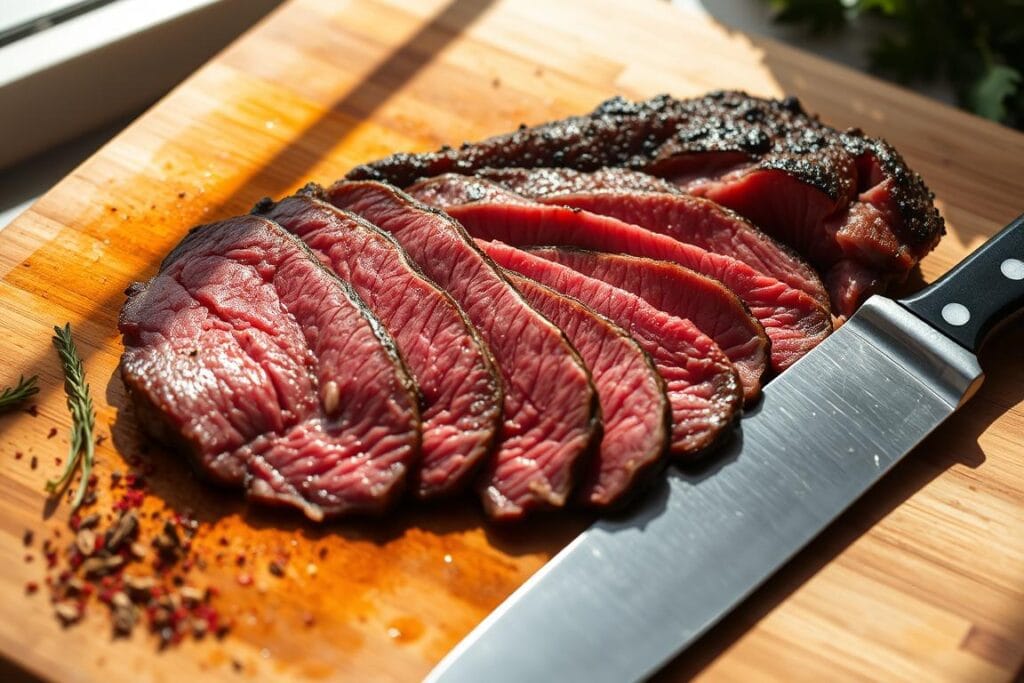
Proper Slicing Tools
A sharp knife is essential for slicing your steak properly. Dull knives can tear the meat, damaging its texture and causing juice loss. Opt for a long, thin slicing or carving knife that allows you to cut across the entire width of the steak in smooth, single motions.
It’s also beneficial to use a proper cutting board with a channel around the edge to collect the juices that escape during slicing. Avoid using serrated knives as they tend to shred the meat fibers rather than slicing through them cleanly.
Delicious Ways to Serve Marinated Flank Steak
Now that your marinated flank steak is cooked to perfection, let’s explore the various ways to serve it. The right accompaniments can elevate the dish, making it a memorable culinary experience.
Classic Pairings and Side Dishes
When it comes to serving marinated flank steak, classic pairings never go out of style. You can serve it with traditional sides like roasted vegetables, mashed potatoes, or a fresh salad. These options complement the rich flavor of the steak without overpowering it.
For a more substantial meal, consider pairing your flank steak with grilled or sautéed vegetables, such as asparagus or bell peppers. The charred steak pairs beautifully with the smoky flavor of grilled vegetables.
Creative Serving Ideas
To add a creative twist to your meal, try using your marinated flank steak in dishes like steak salads, tacos, or sandwiches. Slicing the steak thinly against the grain makes it perfect for these applications.
You can also incorporate your flank steak into international dishes. For example, use it in a Korean-style BBQ bowl with kimchi and steamed rice or in a Mexican-inspired dish with salsa and avocado.
Sauce and Topping Options
The right sauce can make a significant difference in the flavor profile of your marinated flank steak. Consider using a tangy and fresh Cilantro Jalapeno Chimichurri Sauce as a topping. This chimichurri is a perfect complement to the earthy, smoky grilled steak.
Other sauce options include creamy horseradish sauce for a spicy kick or soy-ginger sauce for an Asian-inspired flavor. You can also offer compound butters infused with herbs or garlic for added richness.
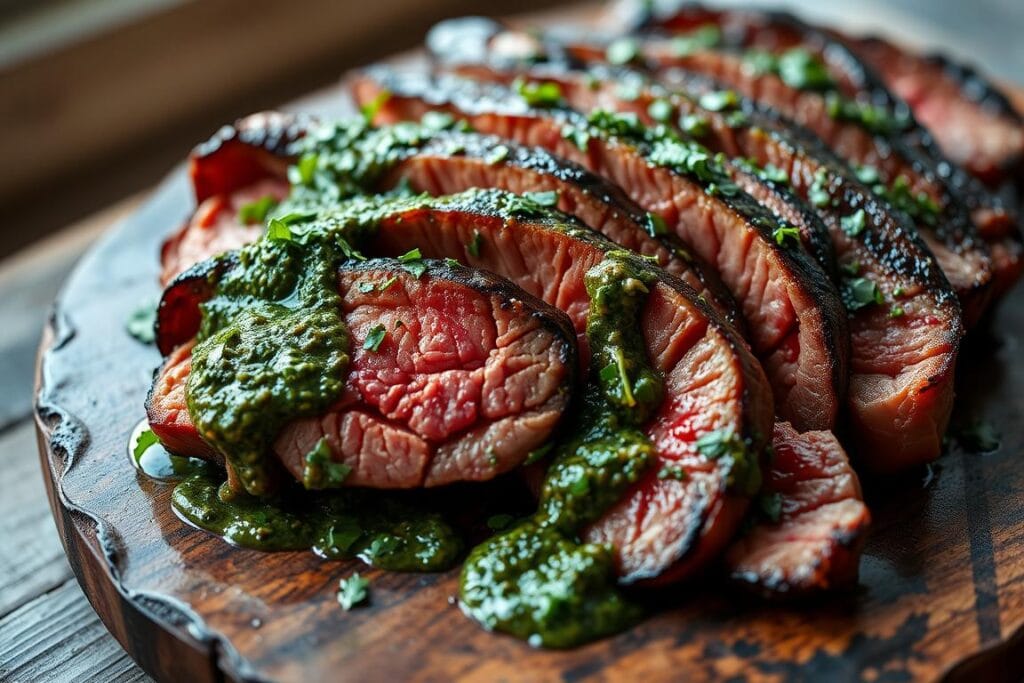
When serving to guests, consider offering multiple sauce options to allow everyone to customize their steak experience according to their personal preference.
Storing and Reheating Leftover Flank Steak
Properly storing and reheating leftover flank steak is crucial to maintaining its flavor and texture. When you have cooked more steak than you can consume in one sitting, it’s essential to handle the leftovers with care.
Proper Storage Methods
To keep your leftover flank steak fresh, store it in an airtight container in the refrigerator within two hours of cooking. You can also wrap it tightly in plastic wrap or aluminum foil. Make sure to press out as much air as possible before sealing to prevent dryness.
When storing, it’s a good idea to slice the steak against the grain first, as this makes it easier to reheat and serve later.
Best Reheating Techniques
Reheating leftover flank steak requires some care to prevent it from becoming tough or dry. Here are some effective methods:
- Avoid using the microwave whenever possible, as it can result in uneven heating and a tough texture.
- Bring refrigerated steak to room temperature for about 30 minutes before reheating for more even warming.
- The oven method is effective: wrap the steak loosely in foil with a tablespoon of beef broth or water, and heat at 250°F for about 15-20 minutes until warmed through.
- For a quick stovetop method, slice the steak thinly and reheat it in a skillet with a splash of beef broth over medium-low heat, just until warmed.
| Reheating Method | Temperature | Time |
|---|---|---|
| Oven | 250°F | 15-20 minutes |
| Stovetop | Medium-low heat | Just until warmed |
To avoid the texture changes that can occur with reheating, consider serving leftover flank steak cold or at room temperature in salads or sandwiches, ensuring it doesn’t become dry.

Troubleshooting Common Flank Steak Problems
Even with the best preparation, issues can arise when cooking flank steak. Understanding how to address these problems can help you achieve a more enjoyable dining experience.
Tough Steak Issues
If your flank steak turns out tough, it might be due to inadequate marination or incorrect slicing. Always slice against the grain to ensure tenderness. If the steak is overcooked, it can also become tough.
To avoid toughness, make sure to marinate the steak for the recommended time and cook it to the right level of doneness.
Fixing Flavor Issues
Flavor issues can arise if the marinade is not potent enough or if the steak is not cooked correctly. Adjusting your marinade recipe or ensuring that the steak is cooked at the right temperature can help.
Using a flavorful sauce can also enhance the taste of your flank steak. Consider adding a rich sauce or serving it with a side that complements its flavor.
Salvaging Overcooked Steak
Overcooked flank steak doesn’t have to be a disaster. You can repurpose it into dishes where additional moisture can compensate for dryness. For example, you can make steak tacos with salsa, beef stroganoff, or steak soup.
Thinly slicing the overcooked steak against the grain and briefly simmering it in beef broth or sauce can reintroduce moisture. Creating a flavorful pan sauce with wine, broth, and butter can also help mask dryness.
| Issue | Solution |
|---|---|
| Tough Steak | Slice against the grain, avoid overcooking |
| Flavor Issues | Adjust marinade, use flavorful sauce |
| Overcooked Steak | Repurpose into moist dishes, use pan sauce |
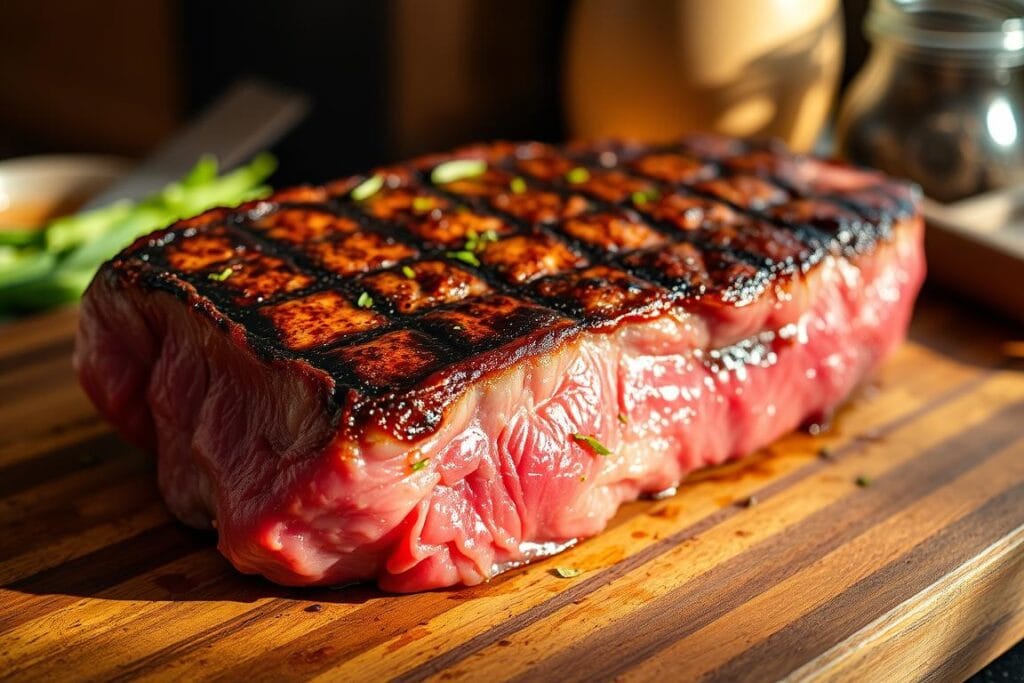
Conclusion
As you’ve learned throughout this article, preparing a mouth-watering marinated flank steak is easier than you think, and the results are well worth the effort. By following the guidance provided, you’ve gained the knowledge to select, marinate, cook, rest, and slice flank steak for optimal tenderness and flavor every time.
The marinated flank steak recipe is not only a testament to the power of proper preparation techniques but also a versatile dish that can be adapted to various cuisines and serving styles. Whether you’re cooking for casual family dinners or special occasions, this recipe is sure to impress. The combination of soy sauce, balsamic vinegar, lemon juice, brown sugar, and seasonings in the marinade infuses the meat with complex, savory, tangy, sweet, and spicy notes.
Remember, the keys to success with flank steak are adequate marination time, cooking at the proper temperature, allowing sufficient rest time, and slicing against the grain. With practice, this marinated flank steak will become a go-to in your cooking repertoire—a reliable, impressive dish that delivers exceptional results with minimal effort and expense. So, fire up your grill and get ready to enjoy a deliciously tender and flavorful meal that’s sure to become a favorite.
FAQ
How long should I marinate my beef?
What’s the best way to grill a flank cut?
Can I use a different type of cut, like skirt steak?
How do I determine the doneness of my beef?
What’s the best way to slice the meat?
Can I store leftover beef in the refrigerator?
What are some common mistakes to avoid when cooking beef?
Can I add other ingredients to the marinade?

Marinated Flank Steak: The Perfect Steak for Any Occasion
- Total Time: 25 minutes (plus 2–24 hours marination)
- Yield: 4 servings 1x
Description
Marinated Flank Steak is a flavorful and budget-friendly dish that transforms a lean, tough cut into a juicy, tender main course with the help of a rich, savory marinade. Perfect for grilling, broiling, or stovetop cooking, it’s ideal for weeknight meals or special occasions. Sliced against the grain and paired with your favorite sides or sauces, this steak always delivers mouthwatering results.
Ingredients
1 flank steak (about 1–1.5 lbs)
½ cup olive oil
¼ cup lemon juice
2 cloves garlic, minced
1 tbsp balsamic vinegar
1 tsp dried oregano
Salt and pepper, to taste
Optional: red pepper flakes, to taste
Instructions
In a bowl, whisk together olive oil, lemon juice, garlic, balsamic vinegar, oregano, salt, pepper, and optional red pepper flakes.
Place flank steak in a sealable bag or shallow dish. Pour marinade over it and turn to coat. Seal or cover.
Refrigerate and marinate for at least 2 hours, or up to 24 hours. Turn occasionally.
Preheat grill, broiler, or skillet to medium-high heat. Remove steak from marinade and let excess drip off.
Grill or cook for 5–7 minutes per side, depending on thickness and desired doneness.
Remove from heat and let steak rest for 10 minutes.
Slice thinly against the grain. Serve warm with your favorite sides or sauces.
Notes
Don’t over-marinate; acidic marinades can make meat mushy if left too long.
Always slice against the grain to maximize tenderness.
Use a thermometer to check doneness: 135°F for medium rare.
Letting the steak rest after cooking helps retain juices.
Customize the marinade with herbs, soy sauce, or chili for variation.
Store leftovers in an airtight container in the fridge for up to 3 days.
- Prep Time: 10 minutes
- Cook Time: 15 minutes
- Category: Main Course
- Method: Grilling (also suitable for Broiling or Stovetop)
- Cuisine: American
Keywords: Marinated flank steak, beef marinade, grilling recipe, easy steak dinner, flank steak recipe, meal prep beef, affordable steak, BBQ flank steak, juicy steak, grilled meat
What Are Our Readers Saying?
There are no reviews yet. Be the first one to write one.

